Archived Water Damage Blog Posts
Why do you "flood cut" a wall?
8/5/2022 (Permalink)
After a major water intrusion in a home, it's incredibly important to react quickly and comprehensively to remove the water and dry the structure out.
If you react immediately and are able to extract or remove the water after turning off the source, then the level of mitigation and restoration that you need might be minimal. A little bit of air movement and dehumidification may do the trick.
However, if that water is allowed to sit and wick up your walls, then you might have a bigger problem on your hands.
After all, how do you dry out water that's already inside the wall cavity?
This situation happens all the time, and it's why we perform "flood cuts" relatively often on bigger water damage projects. If we're not called in until after the water has gotten behind the wall, then we're forced to open up the wall to dry it.
How do I extract water on my own?
8/5/2022 (Permalink)
If you have a water damage event in your home, then you have a very limited timeline to stop it, mitigate it and stabilize the environment before it spirals out of control.
While SERVPRO is always quick to respond, it still takes some time for us to dispatch to your home after a water intrusion. Anything that you can do to mitigate the damage on your own before we get there is extremely helpful and will save you time and money on the restoration.
Extracting water should be one of your top priorities. There are many ways that you can extract with items that you already have in your household.
Obviously, if you have a vacuum that is capable of vacuuming up liquids or wet materials (like many Shop-Vacs are), this can be a great tool.
But even throwing down some towels to soak up water and prevent it from reaching vulnerable or high value areas is super effective.
Why are there categories of water damage?
7/14/2022 (Permalink)
Most industries share a common lingo and lexicon that allows them to communicate with accuracy and nuance about the specialized things that they deal with every day.
The water restoration and mitigation industry is no different. Restorers have all sorts of different ways to quickly communicate the pertinent details of a water damage situation and figure out what to do next with only a handful of words.
This is why you may hear water damage restoration providers refer to different “categories” of water. Water damage has been broken down into separate categories so that restorers have shorthand for referring to different levels of contamination, and a rubric for dealing with them.
That said, water category is not exactly a scientific term and it is not set in stone. In fact, the category of water can change drastically as environmental conditions change or certain things happen. Clean water that runs through an asbestos-containing wall, for instance, can easily become contaminated and change category.
What is category 1 water damage?
7/14/2022 (Permalink)
If you were able to listen in on a private conversation between two water damage professionals, chances are you might not be able to even follow what they’re talking about.
Our industry has so much insider knowledge and shared, specialized lingo that it can sometimes be difficult for the average person to follow.
Take, for example, the concept of “category 1” water damage.
Water damage categories refer to the level of contamination in the water itself. They go from 1 to 3, ascending as more contamination is added.
By that logic, category 1 damage is the least contaminated. In fact, by definition, category 1 water is “clean water” and should actually be drinkable.
That doesn’t mean you’d actually want to drink it. The most common sources of category 1 water include water from toilet supply lines and burst pipes.
That said, if you have category 1 water damage, it could be much worse. With clean water, you have the best possible chance of drying and salvaging your structure and contents in a safe and sanitary way.
What is category 2 water damage?
7/14/2022 (Permalink)
Every industry has its own language. Computer programmers talk about “syntax” and programming languages with ease, even if their conversations are totally inscrutable to others. Healthcare is full of scientific terms and enough acronyms to make your head spin.
Water damage restoration is no different. Among other things, restorers have developed a common language to describe the level of contamination in water using a system of “categories” numbered 1 to 3.
Today, we’ll cover category 2 water damage. What is it and how bad can it be?
Category 2 water is sometimes referred to as “gray water.” In terms of contamination, it’s right in the middle and can sometimes be the most difficult category to define. Technically, the amount of contamination is said to be “significant” but not enough to qualify as category 3.
Examples include water leaking from a dishwasher and water from a toilet that has been flushed.
Because of the level of contamination, category 2 water damage will likely involve a significant amount of porous material removal.
What is category 3 water damage?
7/14/2022 (Permalink)
Today, we’ll be talking about the third and final category of water: category 3 water damage.
Water “categories” are used by restoration professionals to quickly identify and communicate the level of contamination in water. These categories are not usually determined by any kind of scientific test (though such tests do exist) but instead are highly-educated guesses based on the source of the water and the materials that it has passed through.
Category 3 water is sometimes referred to as “black water” and is the most contaminated category that exists. It is considered to be “grossly” contaminated with harmful bacteria, viruses and pathogens that could cause serious health problems, even death, if they were to be ingested.
The most common source of category 3 water in the home is sewage. A sewage backup can contain not only the sewage itself, but also whatever pollutants, chemicals and harmful materials that were picked up as the sewage traveled through the sewer.
Category 3 water damage leads to the highest ratio of demolition and material removal, as many things can simply not be effectively cleaned and sanitized after exposure.
Why Get Lead and Asbestos Testing on Water Jobs?
7/9/2021 (Permalink)
On many of the water damage jobs that we complete, we call in an independent, third-party company to test for lead and asbestos. For many people, that comes as a surprise.
Unless you’ve experienced catastrophic water damage yourself, you probably don’t know much about the restoration process.
Most people, when they call us, assume that the bulk of the water damage restoration process entails extracting standing water and maybe setting up a few fans.
If only that were true. In many cases, if the water sits for any extended period of time, it will wick up into the structure and become trapped. Even if a wall feels dry to the touch, it could hold tremendous amounts of moisture that will cause structural damage and mold growth if not properly dealt with.
Sometimes, it’s possible to dry a wet wall simply through air movement and dehumidification. But often, we run into situations where it is faster and more cost-effective to cut out a portion of the wall so that we’re able to access trapped moisture directly.
That’s where lead and asbestos testing often come in. In the seventies, the United States outlawed the use of lead-based paint and many asbestos-containing building materials. Most structures built before that point have some level of lead and asbestos.
So, before we have to do demolition on a water job, we’ll often bring in a third-party company to test for lead and asbestos. This can slightly extend the timeline, but it’s worth it to keep homeowners and our team safe.
Water Damage Restoration in Confined Spaces
7/9/2021 (Permalink)
In the typical residential water damage restoration job, we find ourselves in a basement or a bathroom. These jobs are not always easy, but we’re at least working within rooms that were meant for human habitation.
Sometimes, though, we have to work in what’s called a “confined space.” A confined space is defined as any space that:
- Is configured so that someone can enter it;
- Has limited means of entry and exit;
- Has the potential for containing atmospheric hazards;
- Is not designed or intended for continuous occupancy.
The last point is the real kicker – these are spaces where human beings were never supposed to go, and certainly were never supposed to spend extended lengths of time. Crawlspaces under houses, for example, would be confined spaces.
While not every restoration company is capable of working within a confined space, we have the training and the safety procedures to perform restoration wherever and whenever you need us. Those safety measures might include hiring an attendant to monitor the space’s entrance, installing a retrieval line, and conducting extensive testing for atmospheric and other hazards.
Of course, you’re never quite prepared for what you’ll find in a confined space. All we’ll say is that, if you crawl into three foot tall crawlspace and you see another set of eyes staring back at you, get out of there as quickly as you can.
The First Step of Water Damage Restoration
7/9/2021 (Permalink)
Every single water damage restoration job is different. That’s one of the things that makes our job so interesting – you never work the same job twice.
That said, almost every single job starts with the same step: identifying and stopping the source of the water.
That might seem obvious (after all, if you have water gushing into your house, you’d want it to stop, right?). But for many people, it comes as a surprise. All they see is water standing in their basement that they want to get rid of, and they don’t always understand why we’re so adamant that the source be shut off before we begin.
The major reason is that, if you can’t stop further damage from occurring, then performing mitigation is useless. Sure, we can extract some of the water and even set up equipment, but if the water comes pouring back in (or even if it trickles back in and accumulates), that work was just a costly waste of time.
In addition, identifying the source of the water helps us figure out what kinds of work and safety protocols that we have to follow. To the naked eye, water from a toilet supply line and water from an exterior flood might look very similar on your basement floor. On a microbial level, however, there’s a world of difference.
So if you’re dealing water damage, remember: step one is to stop the water.
The Second Step of Water Damage Restoration
7/9/2021 (Permalink)
After identifying any safety hazards and stopping the source of the water intrusion, the second step of water damage restoration is to answer the question “what’s wet?”.
This question can be trickier than you’d think. Water has a tendency to migrate far and wide throughout a structure in ways that can be extremely difficult to predict. Our job is to find the “edges” of this migration so that we can properly scope out the restoration project.
It is INCREDIBLY important for any restoration professional to be comprehensive when figuring out what’s wet. It’s on us to inspect all potentially affected areas so that we can scope the project properly for the homeowner and their insurance carrier. That means that if you have a toilet leak on the third floor of your house, we may have to inspect the ducting all the way in your basement crawlspace to know for sure whether it has been affected or not.
As we go, we’ll also protect any belongings that are in wet areas. This might include blocking and padding furniture, removing or lifting clothing and draperies, removing metal objects and ensuring that the water does not migrate onto any dry surfaces.
Once we know “what’s wet,” we can then go on to scope and complete the water damage restoration work.
Categories of Water Damage
7/9/2021 (Permalink)
In water damage restoration, we share a common lingo with our peers in the industry, as well as the insurance adjusters that we work with.
For example, we define different types of water in three different categories. The water’s category is determined by four factors: source, time, temperature, and pre-existing condition.
Category 1 water, also sometimes called “clean” water, is water that has no substantial risk of causing sickness or discomfort. If the water has come from a broken water supply line, for example, it’s considered to be Category 1.
Category 2 water, meanwhile, carries a significant degree of chemical, biological or physical contamination. Category 2 water is sometimes referred to as “grey” water. It might include water from a dishwasher leak, or an aquarium, or even a waterbed. It could even be Category 1 water which has been allowed to sit for an extended period of time. It might not be the most contaminated, but you certainly wouldn’t want to drink it or handle it without proper protection.
Category 3 water, also known as “black” water, is considered to be “grossly” contaminated. Sewage from beyond the toilet trap, water from a septic system, or floodwater that has swept up contaminants from outside are all considered to be Category 3 and must be handled with extreme caution.
If all of this lingo is over your head, don’t sweat it – the important thing to remember is that if water is contaminated, or even if it has been standing, it carries a risk of causing health effects.
Primary vs. Secondary Water Damage
7/9/2021 (Permalink)
Over the course of a water damage restoration project, you may hear the terms “primary” and “secondary” water damage. As a homeowner, you might not care much about the distinction – after all, all you want is for the damage to be gone – but as a professional restoration company, it’s vital for us to know the difference.
Primary damage is the damage that occurs when your structure and contents first come into direct contact with water. If your ceiling bursts because of the weight of the water pouring into it, that would be an example of primary damage.
Secondary damage, meanwhile, is the damage that occurs when excessive moisture is allowed to sit inside a structure for an extended period of time. When moisture remains and humidity is high, it can cause irreversible damage to building materials as well as promote the growth of all sorts of nasty microbes, including mold.
Often, by the time we’re called to the scene, primary damage has already occurred. Our first order of business is to prevent secondary damage from occurring through restorative drying. Once we stop any further damage from occurring and properly dry the structure, then we can call in our reconstruction team and handle the primary damage as well. It’s all part of making your loss “Like it never even happened.”
How Long Does It Take for Mold to Grow After Water Damage?
7/1/2021 (Permalink)
Water is the stuff of life. It covers most of the planet, makes up the majority of our bodies, and sustains every life form on Earth.
That’s great, but it also means that when you have a water intrusion in your home, you’ve created an environment where life can thrive. Microscopic organisms can multiply rapidly in areas of unusually high moisture and humidity, especially when a food source is available (like, say, the paper on your drywall).
The key to preventing mold growth is a fast response. But how fast? How long does it take mold to develop after water damage?
The Timeline for Mold
The basic rule of thumb that most mold remediation technicians will tell you is that mold colonies can start to grow within 24 to 48 hours in the right conditions. If they have moisture, and they have something to eat, you’re at risk of an infestation.
Like anything else, this is not a black-and-white rule. We’ve seen situations where contaminated water has sat for nearly a week and no mold has developed. We’ve also seen situations where a seemingly uncontaminated home can become a dank, mold-infested biohazard over the course of a weekend.
Our advice is to assume the worst – if you let water and moisture sit for more than a day without taking any measures to reduce humidity, promote drying and inhibit the growth of mold, you stand a very good risk of starting an infestation.
That’s why we’re available 24/7/365. If you’re dealing with a water loss, call 716-674-1103 – we’re here to help.
Vacuum Freeze-Drying for Document Restoration
7/1/2021 (Permalink)
Here’s a vocabulary word for you: “sublimation.”
You may have run into “sublimation” in science class, way back when. It’s the word for when a solid (as in ice) turns directly into a gas (as in water vapor) without ever becoming a liquid (as in water).
You might be thinking “impossible!”, and we wouldn’t blame you. If you’re thinking about ice melting, then sublimation might seem like an impossibility.
But with vacuum freeze-drying, sublimation is a predictable, manageable process. And it’s exactly what we use to dry documents that have suffered water damage.
How does vacuum freeze-drying work?
Say you run a medical office, and your sprinklers went off in your records room. The records that you are required to keep, by law, for your patients have been soaked. You need to restore them in order to maintain compliance, so you call the SERVPRO of West Seneca/Lancaster document restoration team in to help.
Our team will bring the documents to a special drying chamber designed for vacuum freeze-drying. The wet documents are frozen solid in order to maintain their structure and integrity. Then, a high-pressure vacuum is used to remove any air from the chamber.
Within this vacuum chamber, the pressure and temperature can be strictly regulated to convert the moisture in the documents into water vapor without allowing it to revert back to its liquid form.
This vapor is then collected via a condenser that can achieve temperatures of -40ºF, which turns it back to ice for disposal. Over time, the temperature is gradually increased within the chamber to remove more moisture from the documents safely, until they meet our dry standard and are restored to their preloss condition.
It’s a high-tech process, so if it seems a little bit crazy, don’t sweat it. All you really need to know is that if your documents get soaked, call SERVPRO of West Seneca/Lancaster immediately. We’re here to help.
The 5 Principles of Drying
7/1/2021 (Permalink)
At SERVPRO of West Seneca/Lancaster, we follow the IICRC’s S500 Water Damage Restoration Standard. Our IICRC-certified technicians follow this standard of care because it provides a roadmap for comprehensive, effective and timely restoration that makes our customers’ disasters “Like it never even happened.”
The S500 designates five principles of drying that we adhere to. Here’s what they are.
Principle 1: Provide for the Safety and Health of Workers and Occupants
Our first responsibility is to identify and eliminate safety hazards when we arrive on site. This goes for hazards that affect our team as well as any occupants.
Principle 2: Document and Inspect the Project
Next, we must evaluate how much the water has migrated through the structure and figure out how much moisture has been absorbed. This principle necessitates that we complete a thorough inspection that includes all areas where the moisture might have migrated, as well as ongoing and final inspections.
Principle 3: Mitigate Further Damage
After initial documentation and inspection, our priority is to mitigate any further damage. Without mitigation, water will continue to migrate, humidity and moisture levels may continue to rise, and there’s a distinct possibility that further secondary damage will occur.
This principle also covers the control of contaminants, like microbial growth. A quick response is vital for limiting this kind of secondary damage, since mold outbreaks can occur within as little as 24 hours after abnormal levels of moisture arise.
Principle 4: Clean and Dry Affected Areas
While some materials may need to be replaced after water damage, we make an effort to both clean and dry whatever we can, so long as it makes financial sense for all materially interested parties.
While we won’t get into the full potential scope of cleaning and drying here, suffice to say that there are many different techniques to employ, and many different variables to control, in order to make water damage “Like it never even happened.”
Principle 5: Complete the Restoration and Repairs
Our job does not end when everything is dry. Our job ends when we return your home to preloss condition. Whether this means re-installing baseboard or building you an entirely new house, we’re ready and prepared to do it all.
These five principles guide us on every single water job. If you’ve had water intrusion in your home, call 716-674-1103 – we’re here to help.
Common Hazards in Water Damage Restoration
7/1/2021 (Permalink)
Water damage restoration is an exciting, interesting line of work. No two days are the same, and you’re constantly being called upon to solve problems, think critically and make a difference in the lives of people in your community.
That said, restoration work can also be dangerous. On every single job that we do, our first priority is the health and safety of both our team and any occupants of the structure that we’re working in.
The most common hazard that we deal with is actually somewhat mundane: slips and falls. Even in a major disaster, sometimes the biggest risk is a wet floor.
Past that, there are many hazards that we check for on each and every job. Here’s a list of the most common hazards that we run into:
- Electrical shock
- Gas leaks
- Lead-based paint
- Asbestos-containing materials
- Entering “confined” spaces (i.e. spaces not designed for human habitation)
- Coming into contact with contaminated water (e.g. sewage)
- Leaks of chemicals or hazardous materials
- Damaged construction components or materials (e.g. falling ceilings)
- Exposure to household chemicals without proper packaging or PPE
- Excessive heat
Some of these hazards seem like no-brainers, while others may not seem like such big deals. Take it from us – each and every one of the items on this list can represent a significant health risk in the wrong circumstances.
That’s why the first thing our technicians do is eliminate, contain and communicate hazards to all parties. It’s just one more way that SERVPRO of West Seneca/Lancaster strives to keep you safe.
Saving Water Damaged Ceilings
6/30/2021 (Permalink)
Can you restore water damaged ceilings?
The answer is “sometimes.”
Most ceilings in residential homes are constructed with drywall. Drywall, if you’ve never really looked at it, is mostly made up of layers of paper or cardboard. It’s durable enough to serve as a building material, and quite affordable, but it doesn’t stand up to water very well. When there’s a water intrusion, it can very easily absorb or track large volumes of moisture.
Since paper is an organic material, wet drywall can also be a huge target for mold growth if not dealt with quickly and properly.
That said, it’s not like wet ceilings are a totally lost cause.
When can wet ceilings be saved?
If the water damage is relatively minor, then there’s a good chance we’ll be able to save your ceiling. Much like any other drywall, we’ll likely have to find a way to ventilate it and blow warm, dry air into it to promote evaporation, and then capture the evaporated moisture with dehumidifiers.
Once the ceiling is dried, then it’s just a matter of performing some minor repairs and painting to cover up any imperfections. The process, no pun intended, is pretty cut and dry.
This scenario assumes that the water that your ceiling was exposed to was clean “Category 1” water, and that the structural integrity was not affected. When the water category changes, or the structural integrity goes down, then we have a problem.
When can’t wet ceilings be saved?
If we walk into a home and see a ceiling that is sagging, bubbling or bulging, then we are very likely going to recommend that it be removed, disposed of and replaced. In a state like that, the ceiling has lost its structural integrity and poses a very real threat to both you and us.
Even if the structural integrity has not been affected, we still may recommend removal is the ceiling has become contaminated. Usually, this comes in two forms.
The first is “Category 2” or “Category 3” water. This is water that is either significantly or grossly contaminated by things that could make you very sick, like sewage or pathogens. If that water hits your drywall, there’s really no way to effectively clean it, and it needs to be replaced.
The second is mold growth. Mold growth is preventable but still very common when there’s been water damage. If there’s mold growing on your water damaged ceiling, removal and replacement may be more cost-effective than trying to save it.
For more information on our standard of care, Google the IICRC’s S500 standard – it lays all of this out in more detail.
Certified for Water Damage Restoration
5/13/2021 (Permalink)
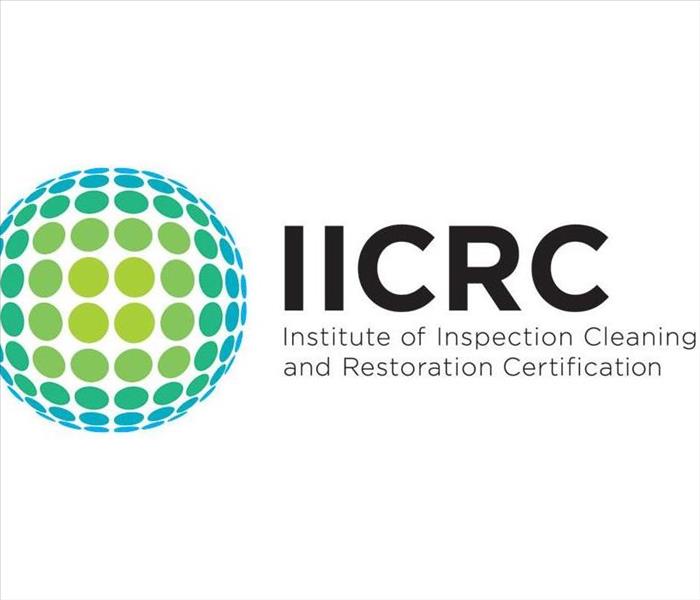 The IICRC sets the standard for the restoration industry.
The IICRC sets the standard for the restoration industry.
At SERVPRO of West Seneca / Lancaster, it's important to us that we provide you with the highest standard of water damage restoration.
We do a lot to make that happen. One of the most important things is certifying our technicians with the Institute of Inspection, Cleaning and Restoration Certification, or IICRC.
The IICRC sets industry standards for the entire field of restoration, and certifying with them is the best way to make sure that our technicians are trained on the latest science in water damage restoration.
Let's take a look at one of the most important certifications that our technicians get: the WRT.
Water Damage Restoration Technician (WRT)
The Water Damage Restoration Technician (WRT) certification that the IICRC offers is one of their foundational certifications, but that doesn't mean that it's easy to get.
To achieve the WRT, our technicians must attend three days of classes totaling 19 full hours of instruction. After that, they must pass a rigorous exam to become fully certified.
The point of this instruction is to deepen the technicians understanding of the science and theory behind the work of water damage restoration. By learning the science, technicians are able to make intelligent choices about the best way to dry customers' structures and contents, which leads to better outcomes for everyone.
The WRT is only one of the certifications that our technicians achieve. The IICRC offers a variety of further certifications in water, fire, mold, structural drying and more. By continuing their education, our technicians ensure that they remain the best in the business.
Removing Water After Prolonged Damage in West Seneca
7/8/2020 (Permalink)
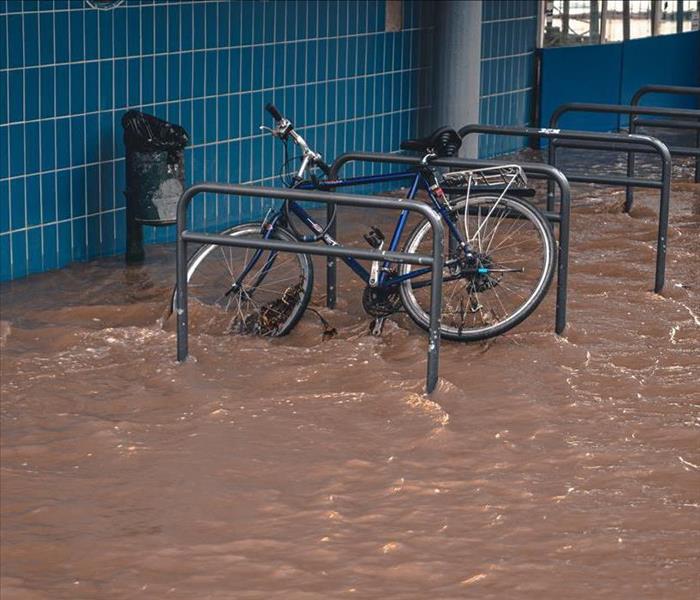 You don't want your basement to look like this.
You don't want your basement to look like this.
Water damage can happen anywhere, but we encounter quite a bit in West Seneca. Often, the core issue is this: there’s a huge storm or snow melt that causes a ton of water to go into local drains, which then get backed up into people’s homes and businesses.
What’s worse is that sometimes, this water can sit for days on end without anyone noticing. Imagine you’re away for a week on vacation and you come back to find standing water in your basement – what could be worse? The longer water stands, the more extensive and serious the damage from that water will be, especially since water is capable of migrating far past its initial point of entry.
That’s when people call SERVPRO of West Seneca/Lancaster, their local water damage pros. Our extensive experience in mitigation and restoration, along with our industry-leading tools and techniques, enable us to restore your home or business to preloss condition even if water has been standing for a long time. Here’s how we do it.
Surface Water Extraction
First things first: we need to extract the water that’s standing on the surface of the floor and any other materials. Much of that moisture has probably already been absorbed, but we need to stop further absorption from occurring, and we also need to be able to get accurate readings on the moisture content of your surfaces. Most of the time, our go-to tools are pumps and wet vacuums to extract that water.
Controlled Drying
Once the water is extracted, now it’s time to dry. Effective drying is about more than installing a few fans and dehumidifiers and calling it a day. Especially when dealing with concrete and hardwood floors, drawing out moisture can be extremely complicated. We’re especially careful not to remove water too quickly, as this can damage the material. By continuously monitoring the rate of moisture removal, we can dry your materials as quickly as possible without incurring further damage.
Demolition and Reconstruction
If water sits in a structure for too long and gets absorbed, that structure may unfortunately become too weak to preserve. Standing water also promotes mold growth, which can lead to additional health issues in the long run.
Because of this, SERVPRO of West Seneca/Lancaster also offers demolition and reconstruction services. Once we’ve extracted and dried your property, we’re able to rebuild anything that’s been destroyed to get you back to preloss condition. It’s just one more way we make it “Like it never even happened.”
More questions about water damage? Need us to come and take a look at a loss? Give us a call at 716-674-1103 – we’re here to help!
Water Damage Restoration in Lancaster, NY
7/8/2020 (Permalink)
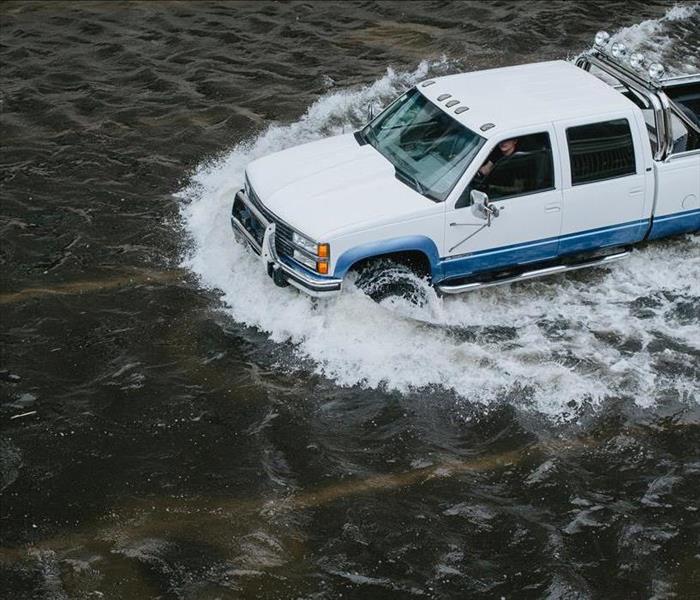 Don't try this at home.
Don't try this at home.
Can SERVPRO of West Seneca/Lancaster help with your water damage issues?
Short answer: yes! We help a ton of businesses all over the region whenever they have issues with flooding, backed up drains and property damage stemming from water. When a home or business owner discovers water in their basement, we’re often their first phone call, which is smart – if water is allowed to sit for too long, it can promote mold growth and lead to lasting structural damage.
What exactly do we do? And how exactly do we do it? We’ll tell you.
Common Types of Water Damage We Deal With
Every water loss is unique, but here are a few of the most common issues that we help people in Lancaster and West Seneca out with:
- Storm damage and flooding;
- Burst pipes, especially in winter;
- Backed up sewer lines and drains;
- Washing machine and sink overflows;
- Toilet and bathtub links;
- Damage after firefighting.
Those are just some of the most common calls that we get, but you can rest assured that if you’re dealing with water damage, we can help.
How We Clean and Restore Water Damage
Our water damage specialists create customized extraction, drying and reconstruction plans for every customer. They have the training and experience to provide the highest level of service available in the West Seneca and Lancaster areas, performing detailed inspections and assessments before getting to work.
Overall, they roughly follow this process:
- Extract any standing water from the property;
- Remove affected contents for drying;
- Utilize industry-leading industrial drying equipment to extract moisture as quickly as possible without causing lasting damage to materials;
- Reconstruct any materials that cannot be returned to preloss condition;
- Clean, sanitize and disinfect the space.
Once we’ve walked through that process, you’ll see for yourself why we pride ourselves on making your water loss “Like it never even happened.” If you need us, we’re here to help – call 716-674-1103 today!
Maintaining Your Basement to Minimize Water Damage
7/7/2020 (Permalink)
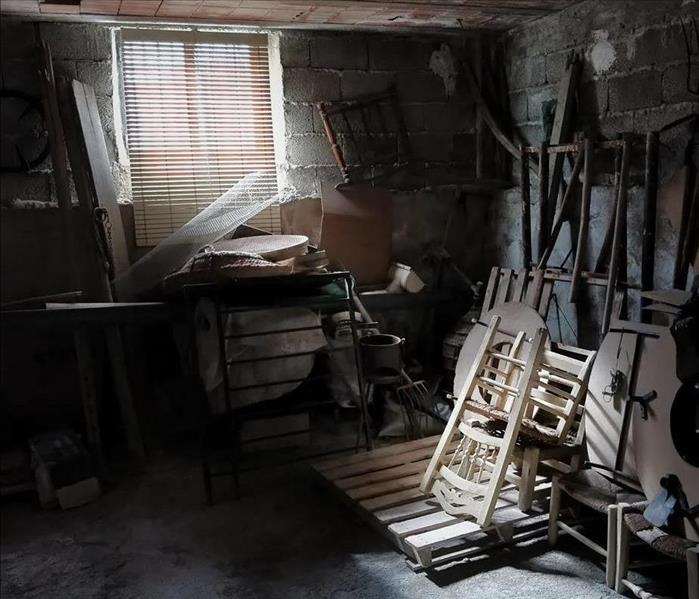 You don't want water getting into your basement.
You don't want water getting into your basement.
Here in Western New York, we’ve already dealt our fair share of storms this year and we can expect to see even more once winter rolls around. Every time that there’s a storm, we get a huge influx of calls here at SERVPRO of West Seneca/Lancaster. Most of the time, these calls are about water damage in a basement.
Why do we see so much water damage in basements? Because water tends to flow to the lowest point it can find. If it can make its way into your basement, it will, causing not just flooding but structural damage and issues with mold as well.
How can you minimize the risk of water damage in your basement? Here are three tips.
Maintain Your Gutters
Your gutters are designed to keep water away from your house, but if they’re not maintained correctly, you can run into serious trouble. Clean your gutters regularly to ensure that they’re not clogged with leaves or other debris. Make sure gutters are attached properly to your house. Finally, run a hose on your roof to check for proper drainage and leaks.
Inspect and Replace Caulking
If your caulking is deteriorating, replace it. Scrape out any eroding caulk and then recaulk as needed. Caulk is sometimes all that stands between water outside your home and water in your basement.
Check Your Sump Pump
When’s the last time you checked on your sump pump? You may take for granted your sump pump’s ability to extract water from your basement, but if it is not properly maintained, it can fail when you need it most.
Testing your sump pump is easy – just remove the lid and slowly pour water down into the well. If your sump pump is working normally, it will turn on once the well is filled, complete a cycle and turn itself off. If that doesn’t happen, then you have a problem.
Of course, no matter how prepared you are, water damage can still happen. If you’re dealing with water damage in your basement, give us a call at 716-674-1103 – we’re here to help!
Sink Overflow? We Can Help!
7/7/2020 (Permalink)
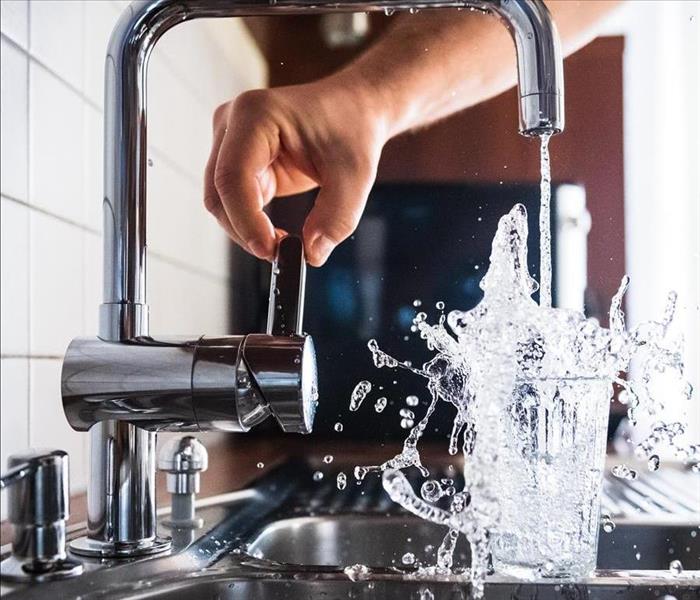 Your sink overflowed. What should you do next?
Your sink overflowed. What should you do next?
An overflowing sink is more than just an inconvenience – it can be a total disaster for your home or business. A sink that is clogged or left running can lead to major water damage if not taken care of quickly. If you want to prevent this kind of damage, follow these prevention and cleanup tips.
How to Prevent Sink Overflows
The best thing you can do to prevent a sink overflow is to stop your drain from getting clogged up in the first place. Just because something can go down the drain does not mean that it should go down the drain.
Food scraps, for instance, should be kept out of the sink as much as possible. If you don’t already have a strainer in your sink drain, get one. You should throw out as much food as possible before dishes end up in your sink, especially things like coffee grounds, pasta, rice and fibrous foods, which are notorious for clogging up drains. The strainer should be able to catch everything else fairly easily – just make sure you keep it clean.
Grease, on the other hand, won’t be caught by a strainer because it runs clear and fluid when it gets hot. It’s only after the grease cools down and becomes gummy that it can pose a problem for your drains, building up on the sides of your pipes over time to create serious clogs. Instead of pouring grease down the sink, place it in a sealable container and throw it in the trash.
On top of food and grease, hair can often clog sink drains up, especially in the bathroom. While a few hairs won’t ruin your sink, a tangled clump of hair can become one of the most stubborn clogs imaginable. A bathroom sink strainer will allow you to throw hair in the trash where it belongs.
How to Clean Up a Sink Overflow
First and foremost, make sure that no more water is overflowing – you don’t want the problem to get worse before you start to make it better.
Your first priority is extraction. Mop up as much of the water as you can, paying special attention not just to your floors but to pantries and cabinets that may also have let water in as well.
Once you’ve removed as much water as you can, move on to drying. Open all cabinets so they can get some airflow, then get as many fans as you can find and start running them in the affected area. Keeping the air moving is vital for drying.
Once everything’s dry, go through and clean all surfaces with an antibacterial cleaner. Even if the water that overflowed was clean, you want to be sure that there won’t be any bacterial or mold growth over time.
Even if you follow these steps, though, there’s a chance that it won’t be enough. Water can very quickly get under floors and behind walls in a way that’s extremely difficult for the average homeowner to detect and reverse. If you’ve suffered serious water damage caused by a sink overflow, give us a call at 716-674-1103 – we’re here to help!
Restoring Water Damaged Documents
7/3/2020 (Permalink)
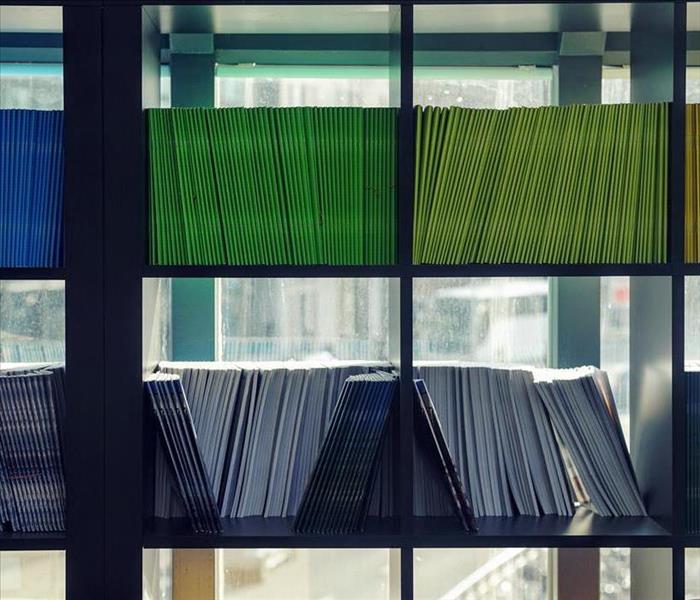 A business's documents are irreplaceable.
A business's documents are irreplaceable.
Sometimes, the most valuable thing lost when there’s water damage isn’t the most expensive but the least replaceable. Important personal documents can easily be damaged when a basement floods or a pipe bursts, and these documents can often be difficult if not impossible to replace. That’s why we’re dedicated to providing the highest quality of document restoration available anywhere in Western New York.
As you can imagine, document restoration after water damage is not easy. Whether we’re helping out a homeowner who needs their personal documents restored or an office with cabinets full of important records, there’s a lot to consider. How serious is the damage? Was the water contaminated?
On top of that, there’s the organizational and record-keeping aspect of the process. We pride ourselves on our methodical approach to restoration, ensuring that any information captured during the restoration is documented as thoroughly as possible so that our customers can access any info that they need while we’re completing the restoration process.
We also keep in close communication with all parties, including insurance companies, to ensure that anyone who needs to be part of the process is never in the dark. We’re also well-versed in the need for privacy and sensitivity, especially when dealing with regulated information (like the medical information protected by HIPAA).
If you’ve suffered a water loss and you need document restoration, we’re here to help. Call SERVPRO of West Seneca/Lancaster today at 716-674-1103 to discuss your options.
What to Do When Your Ceiling is Leaking
7/3/2020 (Permalink)
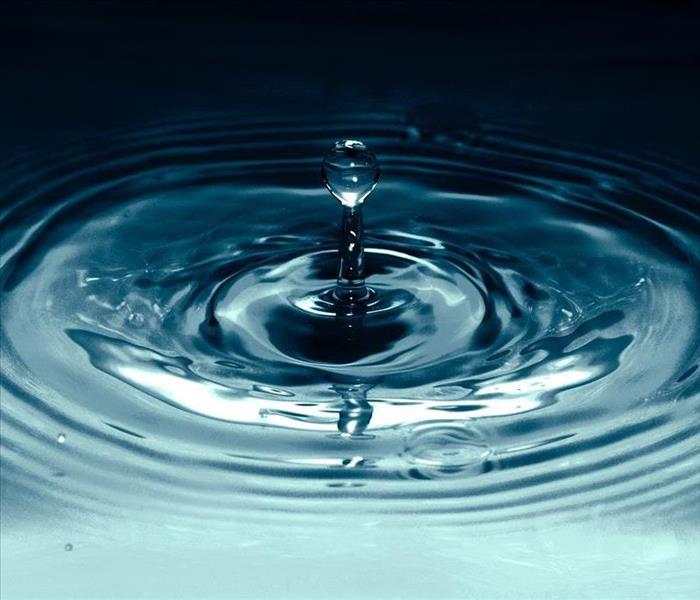 A leaking ceiling is more than a nuisance - it can easily become a disaster.
A leaking ceiling is more than a nuisance - it can easily become a disaster.
Have you just discovered a leak in your ceiling? What a pain, right? In cartoons, people can put a bucket under a leaking ceiling, wait a few hours and the problem takes care of itself. If only real life were so easy…
The signs of a leaking ceiling are obvious: dripping water, discoloration in tiles and plaster, and paint that’s peeling away are hard to miss. However, it can be very tough to actually figure out where the water is coming from. Water does not always drip straight down, hit your ceiling, and come out the other end. It can travel along pipes and other material in your ceiling before finally hitting the surface, meaning that tracking the source down can be a nightmare.
No matter the cause, a leaky ceiling is more than an annoyance – it can lead to mold, structural damage and other serious consequences if not handled correctly.
If you’ve got a serious problem, you should call a professional ASAP. In the meantime, here are some steps to take.
Find the Source
If you can, track down the source of the water and fix it. A leaking ceiling can be caused by a variety of sources, some more obvious than others. A burst pipe or a backed up drain can be pretty easy to find. A leak in a roof might not be. But if you’re able to figure out where the water is coming from and stop it, you’re able to prevent any further damage from occurring.
Dry the Ceiling
To the greatest extent that you can, you want to dry out the spot that’s leaking. Fans and dehumidifiers are your friends here. You may have a few residential units to use, but if the damage is really bad, you might want to think about renting some larger commercial units instead, as well as scaffolding to get them closer to the ceiling.
Paint and Repair
Assuming you were able to fix the source and dry the ceiling out, you may be ready to make repairs. Scrub away any loose debris, wipe the area down and ensure it has dried completely. If your ceiling is painted, primer can be used to block out water spots before blending in a few coats of paint to cover the damage. If your ceiling is plaster, fill in the gaps with new plaster and you should be good to go.
We should mention: all of these steps assume a source that’s easy to find and fix and damage that’s minor. If you have a more serious problem, you’re better off calling the pros instead of fixing it yourself. At SERVPRO of West Seneca/Lancaster, we’re always here to help – give us a call at 716-674-1103 when you need us.
How Long Will It Take to Reopen My Business After a Water Loss?
6/10/2020 (Permalink)
 We're dedicated to helping you reopen after a water loss.
We're dedicated to helping you reopen after a water loss.
When business owners call us to get more information about water damage mitigation and restoration, they’re often in a real bind. Unlike a homeowner, a business owner isn’t dealing with damage to their residence, but they are dealing with damage that could affect their income. This is especially true if the damage is so severe or so central to their business that they’ll have to close until it’s cleared up.
So it’s no surprise that business owners commonly ask us just how long the restoration process will take. While the length of the process really depends on the extent and type of damage, we can at least walk you through some common scenarios and considerations to give you an idea of what to expect.
What factors affect the length of restoration?
While every water loss is different, here are some of the common questions we consider when estimating how severe water damage might be:
- How much water are we dealing with? A few puddles on the ground? A few feet of standing water? Water coming in from a hole in the roof?
- How long has the water been there? How long has it been in contact with the business?
- Is the water clean or unsanitary? What’s the source?
- What types of materials did the water affect? Are there any that require specialty drying?
- How much demolition or reconstruction will be necessary?
Basically, we need to assess not just the extent of the damage, but what was damaged, and which processes we’ll have to follow in order to properly handle it.
How long does it take for permanent water damage to occur?
The short answer: not long. Here’s a quick rundown of your average water damage timeline.
Within the first hour that a leak or flood begins, water will spread as evenly as it possible can throughout the area that it is entering. It will soak everything that it comes into contact with and, if there’s enough water, will also begin to wick up the walls and soak through the floor and the carpet. Any belongings will get soaked, and some more fragile items, like photographs, books, arts and electronics, may be seriously damaged.
Within the first 2 hours, and certainly within a week, you’ll begin to see mold and mildew develop as well if there’s no mitigation plan in place to stop them. This might start as an annoyance, but it could turn into a biohazard without proper care.
Within the first 24 hours, you may also begin to see drywall start to soak, bulge and break. Furniture will also begin to take on water and may start to swell and even crack. Wood flooring may begin to warp as it takes on moisture. Even metal surfaces may begin to tarnish after 24 hours of exposure.
After a week of exposure to water without proper mitigation or restoration, you’re at serious risk of both a mold outbreak and structural problems at your property. The cost of restoration will also go up significantly, as you’ll be looking at remediation and serious reconstruction on top of standard emergency services and restoration.
How can I reopen faster after a water loss?
The best thing you can do when faced with a water loss is spring into action quickly. Call SERVPRO of West Seneca/Lancaster right away to get a crew in there working. Call your insurance agent and see if you can file a claim. If you can do so safely, start to remove contents yourself, and mop or blot up as much water as you can before a crew arrives. When it comes to preventing serious water damage, time is of the essence.
That said, even if you do everything right, restoring water losses takes time. The mitigation and restoration process will likely take at least a few days, especially if water penetrated deep into any hard-to-dry materials. If demolition and reconstruction are necessary, you may be waiting at least a few weeks for the process to be completed.
So if you’re dealing with a water loss, don’t wait – call SERVPRO of West Seneca/Lancaster right away at 716-674-1103 to get the process started! We’ll work with you to not only make it "Like it never even happened,” but also to get your business back up and running ASAP.
What to Do After a Pipe Bursts
6/10/2020 (Permalink)
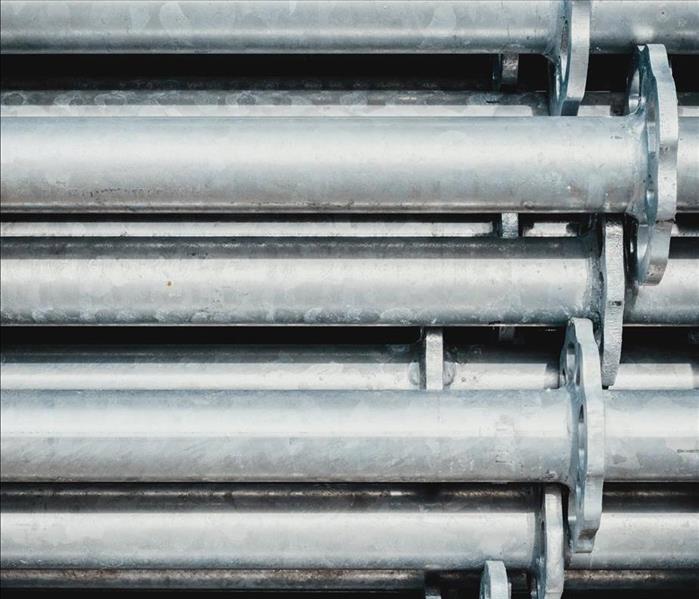 A burst pipe is a serious disaster.
A burst pipe is a serious disaster.
Burst pipes are unfortunately very common out here in Western New York. Blame the winters – the force of water freezing and expanding can very often be more than an old pipe can bear.
If one of your pipes burst, you should stop reading this blog post and call a plumber. Once you’ve done that, try the following to reduce and mitigate any further damage.
Switch off your water supply.
Hopefully you know offhand where your water main is, and you can access it safely. Go find it and shut it off the prevent the flow of more water into your home.
Not sure where your water main is? Usually, it’s somewhere near your water heater in your basement, or tucked away in a crawl space. If it’s external, it may be under a metal lid close to the street.
If safe and necessary, turn off the electricity.
If you can safely access your electrical shutoff, turn that off too to prevent accidentally introducing electricity to the water that’s pooled up.
Drain your faucets.
Just because your water main is off doesn’t mean that all of the water is out of your pipes. To prevent further leaks, you need to drain your faucets, especially the cold water that’s still flowing through your system. Drain your cold taps and flush your toilets a few times. Not only does this reduce the flow of further water, but it also prevents any more water from freezing and bursting your pipes and relieves existing pressure.
After the cold water is clear, you should also turn off your boiler and heating system and drain your hot taps as well.
Warm up your pipes.
Once the water is out of your taps, consider switching the heat back on and turning it up. Warming up the pipes will help to prevent any further freezing and bursting. If you can’t switch on the heat for whatever reason, a hair dryer aimed at the pipe that burst is good in a pinch.
Take pictures.
You’ll want to get as much documentation as possible for your insurance company if you plan to file a claim. Take as many pictures as you can of the area where the leak occurred.
Start cleaning.
The faster that you start to mitigate water damage and remove excess water, the better chance you have of keeping your restoration bill down and avoiding permanent damage. Move whatever contents you can to a safe, dry place that’s out of the way. If there are big pieces of furniture that you can’t move from wet carpet, put wood blocks or foil between the legs and the floor. Mop up or blot as much water as you can.
Call a cleanup and restoration professional.
While there’s lots you can do on your own after a pipe bursts, you can’t do it all. Call the restoration professionals at SERVPRO of West Seneca/Lancaster when you need us – we’re here to help!
Pro's Guide to Toilet Overflow Cleanup
6/10/2020 (Permalink)
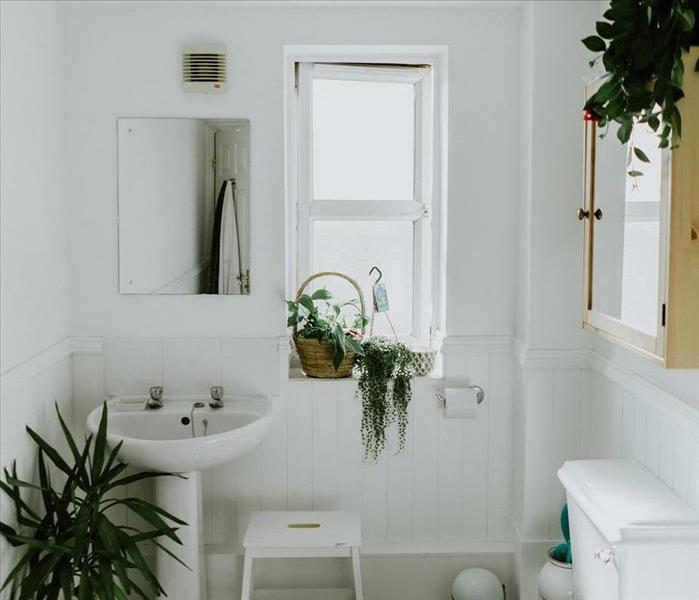 Your bathroom is your sanctuary, until the toilet overflows.
Your bathroom is your sanctuary, until the toilet overflows.
Nobody likes to talk about overflowing toilets, but it happens. Not only is a toilet overflow a huge mess, it’s unsanitary and can lead to not only serious water damage but potential contamination as well.
So how do you go about cleaning something like that up? Do you just grab a mop and hope for the best?
Not exactly. We’ll walk you through the steps you can take in the moments after a toilet overflow occurs.
1. Stop the overflow.
The first order of business is preventing further flow of water and sewage into your home. Open the lid of your toilet tank and look for the circular rubber valve at the bottom of the tank – close that. Then, find the float, which is a rubber sphere attached to a plastic cylinder, lift it up and hold it in place. Next, turn off the toilet’s water valve while holding onto the float. It should be on the back of the toilet. If you’re alone, you may have to let the float go quickly to do this.
At this point, no more water should be flowing into the toilet bowl, and the toilet’s water supply should also be turned off. You’re now in a position where you can focus on cleaning.
2. Start mopping.
Grab a mop and immediately start to pull up as much of the water and waste that you can from the floor. Make sure that you’re wringing the mop out in an empty bucket to prevent any sort of contamination as you work your way through the mess.
3. Plunge the toilet.
Once you’ve cleaned up what you can, grab your plunger and see if you can unclog the toilet. If this doesn’t work after a few minutes, you may have to swap your plunger for a closet auger if you have one. If that doesn’t work, you may have to call in a plumber to deal with the clog.
4. Dump the waste water.
If your toilet is now flushable, dump the waste water down. If not, take it to a different toilet or find another place where you can sanitarily dump it.
5. Disinfect.
Fill the bucket with a sanitizing solution (1 cup of bleach with 1 gallon of warm water works). Sanitize anywhere that might have been contaminated by waste water or sewage using the solution, a mop and a cloth. You’ll probably want to grab rubber gloves for this, and change into clothes you don’t mind getting dirty.
6. Call a restoration company.
If serious water damage has occurred, or the contaminated water has penetrated through to walls, carpets or furnishings, now’s the time to talk to the restoration professionals at SERVPRO of West Seneca/Lancaster. We’ll be happy to come out and take a look at what happened and help you to assess the extent of your issue.
Do You Know How To Stop Further Water Damage In Your Buffalo, NY Home?
7/10/2019 (Permalink)
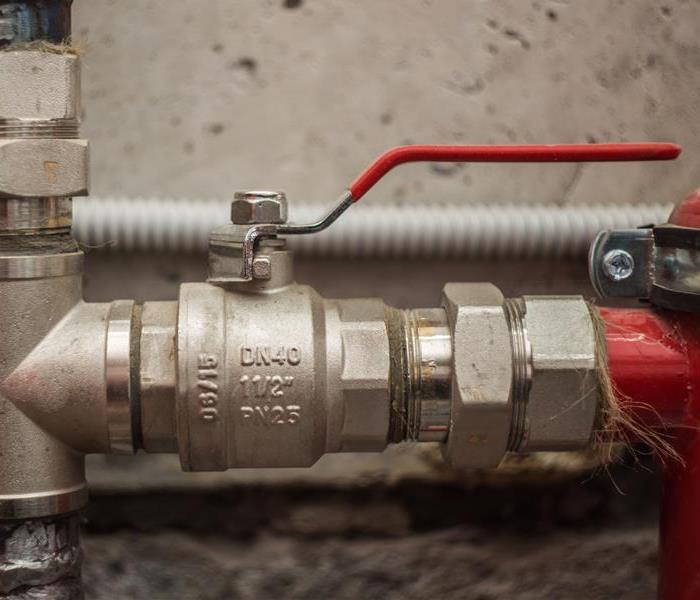 Knowing where, and how to shut off the main water supply in your home can help prevent against further damage.
Knowing where, and how to shut off the main water supply in your home can help prevent against further damage.
You already know time is of the essence when it comes to dealing with water damage, but do you know how you can limit further damage immediately when you discover a burst pipe or overflowing toilet? That’s right, by knowing where your water shut off valve is you can help limit any further damage in your home. In order to start the water mitigation process, the source of the water needs to be stopped. We recommend tagging your water shut off valve so that anyone in the home can easily spot it, and turn it off.
It is important to know how to locate and operate all shut off valves in the home, this include the toilet supply lines, shut offs for sinks and appliances. If you ever notice one of these leaking, shut the water supply off immediately. After calling the professionals at SERVPRO of West Seneca/Lancaster you can begin mopping up excess water. This will also help to limit the damage. Once our team arrives onsite, you just need to sit back while we make it, “Like it never even happened."
We Offer In House Textile Restoration Too
7/10/2019 (Permalink)
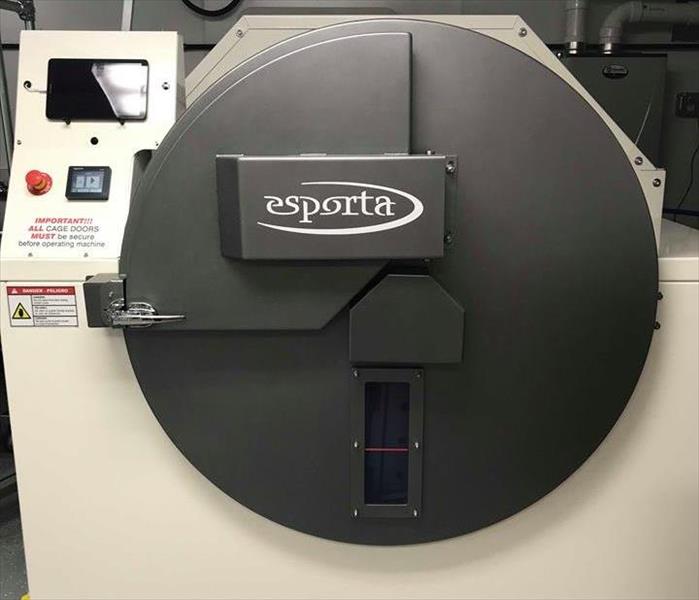 We can now clean up to 90% of the soft goods in your home after a water loss!
We can now clean up to 90% of the soft goods in your home after a water loss!
The days following a water loss can be stressful and overwhelming. Looking at all of the personal items that were affected can send anyone into a panic. You already know SERVPRO of West Seneca/Lancaster can handle the mitigation and cleanup of your home, but we are excited to announce that we can now clean and restore the soft goods and textile in your home as well!
In fact, we can restore up to 90% of the soft goods and textiles in the home. That’s nearly twice the amount a restoration drycleaner can! AND, we can restore and clean them in as little as 48 hours. That means your life is put back together even faster.
So what do we mean by soft goods and textiles? SERVPRO of West Seneca/Lancaster can now restore and clean items such as:
- Soft contents such as stuffed animals
- Sports equipment
- Laundry
- Shoes
- Handbags
- Leather items
- Curtains
- And so much MORE
We can clean and restore all these items and more that have been affected by Category 2 & 3 water, mold and bio contamination. This means you have just one point of contact throughout the entire claim process. So if you experience a water loss call the professionals at SERVPRO of West Seneca/Lancaster at (716) 674-1103 and let us make it, “Like it never even happened."
Time Matters When It Comes To Water Damage
7/8/2019 (Permalink)
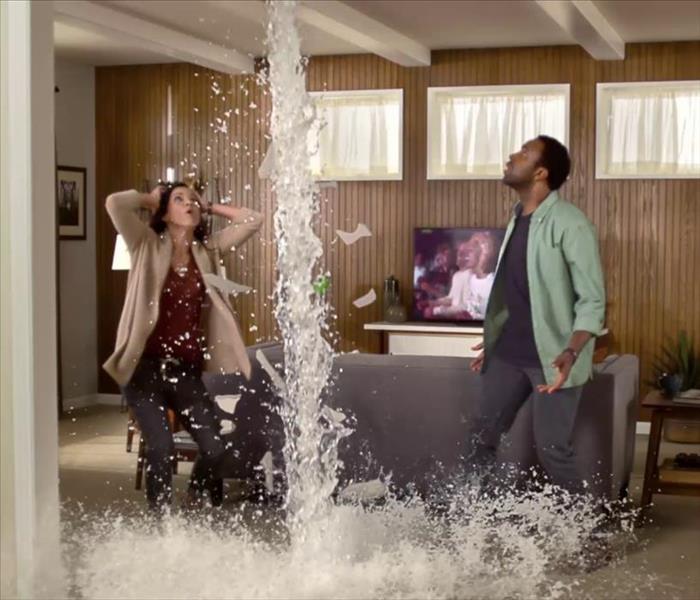 Time matters when it comes to water damage. Don't delay in contacting SERVPRO of West Seneca/Lancaster to begin the mitigation process immediately.
Time matters when it comes to water damage. Don't delay in contacting SERVPRO of West Seneca/Lancaster to begin the mitigation process immediately.
Water damage can happen at any time, any day. That is why SERVPRO of West Seneca/Lancaster is available to help you 27/7, 365 days of the year. We know that once water damage occurs, time matters. Within two hours of your call to our office, someone will be onsite to begin assessing the damage and begin mitigation work if needed. We always have crew on call, ready to assist you with any kind of water damage.
Time matters when it comes to a water loss because within minutes water quickly spreads throughout your property, saturating everything in its path. The water will be absorbed into everything such as walls, floors, upholstery and even your belongings. That water can cause your furniture finishes to bleed, causing permanent staining on carpets and floors. Your priceless photos, book and other paper goods will begin to warp.
Between 24 to 48 hours after the initial loss drywall begins to swell and break down, metal surfaces begin to tarnish and furniture begins to swell and crack. The dyes and inks from cloth and paper goods begin to spread and stain the surface they are on. You may begin to notice a musty odor forming and lingering.
Within just a week mold and mildew will begin to grow and spread. You may notice doors, windows and studs swelling and warping. Metal surfaces will begin to rust and corrode. Paint will begin to blister and wood flooring begins to swell and warp. Your home may now be at a serious risk for a biohazard contamination.
After a week has passed restoration time and cost will increase dramatically, and replacing contaminated belonging and rebuilding of the structure may be extensive. The structural safety, mold growth and biohazard contaminants pose a serious risk to any occupants living in the home. So if there is any water damage in your home, call the experts at SERVPRO of West Seneca/Lancaster right away! Someone from our office is always available at (716) 674-1103 and are “Here to help”.
Right Product, Right Equipment: Water Edition
7/8/2019 (Permalink)
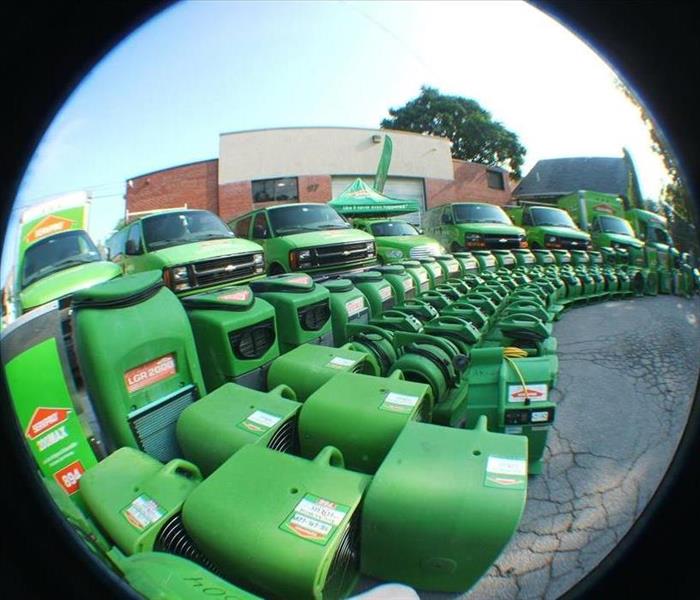 Choose the company with the right equipment and products to make water damage, "Like it never even happened."
Choose the company with the right equipment and products to make water damage, "Like it never even happened."
Having the proper training, equipment and product is key when it comes to restoring water damage. And, here at SERVPRO of West Seneca/Lancaster we have it all! Our technicians are IICRC Certified and go through extensive training so they are prepared to handle any disaster that may arise. They are always on call 24/7 because we know water damage doesn’t always happen during regular business hours. Our professional technicians are trained on how to explain the extent of the damage to our customers in a way that doesn’t sound like a foreign language, and how to show empathy and compassion during this stressful time in the customer’s life.
SERVPRO of West Seneca/Lancaster has all the right equipment to make sure the job is done right the first time. Simply extracting the visible standing water is not enough when it comes to water damage. Water can spread into any porous material (including wood, cardboard and carpet) can cause severe secondary damage if not properly dried and cleaned. That is why we use special air moves, water meter detectors (invasive and non-invasive) and commercial grade dehumidifiers to ensure that every surface in the home is properly dried. Our thermal infrared camera can see water damage not visible to the naked eye, so no damage goes unnoticed.
Using the correct product is another key part between restoring and replacing. All of our products are formulated by our in-house chemist at SERVPRO Headquarters. We have over 150 individual products that are specifically formulated to get the job done right. Each one of our products comes with an MDS sheet so that you know exactly what compounds are in them to avoid any allergens. Also, we have a complete line of natural and sustainable products, giving a whole new meaning to “the green team”.
All of these reasons make SERVPRO of West Seneca/Lancaster the best choice when it comes to restoring your water damaged home or business. Give us a call at (716) 674-1103 if you have any questions. We’re always, “Here to help”.
The Moments After A Water Loss...
7/3/2019 (Permalink)
 The moments after a water loss are crucial. Do not waste time in calling in a professional restoration company to being the mitigation process.
The moments after a water loss are crucial. Do not waste time in calling in a professional restoration company to being the mitigation process.
Did your home just suffer a loss due to a backed up sump-pump or burst pipe? What happens after a water loss can be crucial, and be the difference between restoring and replacing. In order to prevent any further damage in your home, here are some helpful tips:
- Remove as much excess water as possible by mopping and blotting.
- Wipe excess water from wood furniture after removal of laps and table top items.
- Remove and prop wet upholstery and pillow cushion for even drying.
- Place aluminum foil or wood blocks between furniture legs and wet carpeting.
- Turn air conditioning on for maximum drying in the summer.
- Oriental rugs or other colored rugs from wet wall-to-wall carpeting.
- Remove valuable paintings and art objects to a safe, dry place.
- Open and place luggage in sunlight to dry if possible.
- Gather loose items, toys, etc. from floors.
Remember, time is critical when it comes to water damage. So call SERVPRO of West Seneca/Lancaster immediately at (716) 674-1103 to begin mitigation work as soon as possible. After a water loss it is important to NEVER:
- Leave wet fabrics in place; dry as soon as possible. Hang furs and leather goods to dry separately at room temperature.
- Leave books, magazines or other colored items on wet carpets or floors.
- Use your household vacuum to remove water.
- Use TV or other household appliances while standing on wet carpet or floors (especially not on wet concrete floors).
- Turn on ceiling fixtures if ceiling is wet, and keep out of rooms where ceilings are sagging from retained water.
Also, be sure to bring a professional restoration company, like SERVPRO of West Seneca/Lancaster, in to make sure that everything is dried completely and properly. Leaving water damage over a period of time can cause many issues such as secondary damages and mold. So if you just had a water loss in your home call the professionals at SERVPRO of West Seneca/Lancaster a call at (716) 674-1103 today.
Don't Fall Into The Gaps
7/3/2019 (Permalink)
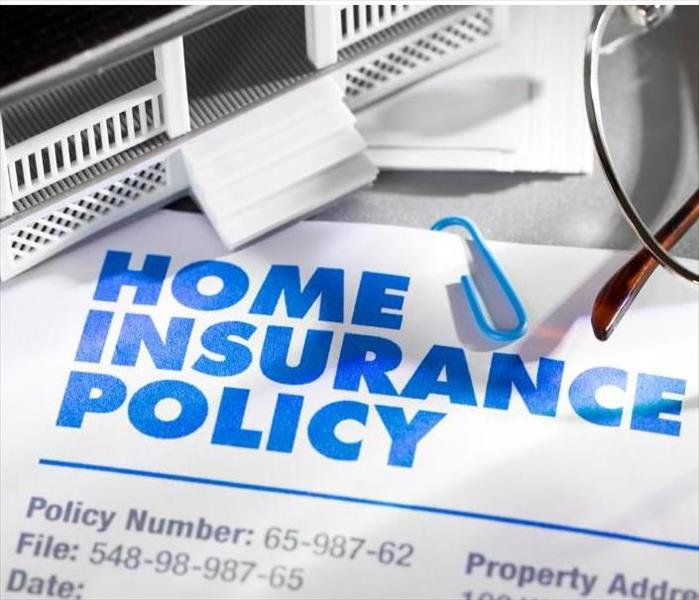 Be sure to review your homeowner's policy and rest easy knowing you have the appropriate coverage.
Be sure to review your homeowner's policy and rest easy knowing you have the appropriate coverage.
All too often we will receive a call from a customer who just suffered a water loss, and while they do have coverage from their insurance company, it is not enough to cover the damages and they are left paying the remaining balance out of their own pocket. Don’t fall into the gap!
While having this coverage on your homeowner’s policy is highly recommended, it is equally important to make sure you have the proper amount of coverage for your home. We generally see coverage for Water Back-up between 5-10 thousand dollars. And, while that may be enough for an unfinished basement, it is often times not enough for a finished one. After the demolition and mitigation work is completed, there may not be enough coverage left to clean the contents in the basement and complete the reconstruction work. What is the solution? Give your insurance agent a call and have them take a look at your current policy. Adjustments to this coverage can happen at any time, and may end up saving you thousands of dollars down the road.
We recommend asking yourself these questions when trying to assess how much coverage you need to protect your West Seneca/Lancaster home:
- Are there any furniture/rugs being stored or used in the basement?
- Do you have any valuables being stored in the basement?
- Are the contents in your basement stored in tots and off the floor?
- Are you planning on renovating the basement in the near future?
- Are there any special features built in the basement that you would want repaired in the event of a loss?
Be sure to communicate these answers to your insurance agent so together, you can determine how much coverage is appropriate. And, should you ever experience water damage in your home, be sure to call the experts at SERVPRO of West Seneca/Lancaster a call at (716) 674-1103 to make it, “Like it never even happened."




 24/7 Emergency Service
24/7 Emergency Service














